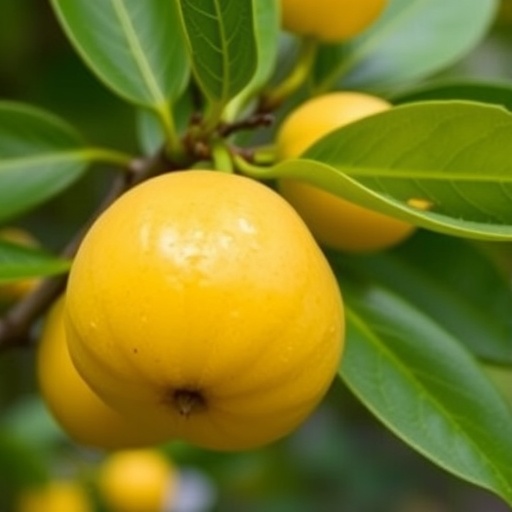In recent years, the rise of multi-drug-resistant bacteria has posed a serious challenge to modern medicine, particularly in the treatment of infections caused by Staphylococcus aureus. This opportunistic pathogen, known for its ability to form biofilms, has become increasingly resistant to conventional antibiotics. In light of these challenges, researchers have turned to nature to find potential solutions. A groundbreaking study led by Jana and colleagues has unveiled the promising anti-biofilm potential of Aegle marmelos fruit extract against multi-drug-resistant strains of Staphylococcus aureus, shedding light on new avenues for combatting antibiotic resistance.
The research specifically targets the biofilm formation, a protective mechanism employed by bacteria that makes them significantly harder to eliminate with standard antibiotic treatments. Biofilms consist of clusters of bacteria encased in a protective matrix, allowing them to withstand harsh environmental conditions, including the presence of antibiotics. As conventional treatment options dwindle, understanding how natural compounds can disrupt these biofilms becomes crucial.
Aegle marmelos, commonly known as bael fruit, has been used for centuries in traditional medicine due to its wealth of therapeutic properties. The fruit is rich in a variety of bioactive compounds, including flavonoids, tannins, and essential oils, which are believed to exert antimicrobial effects. The recent study harnesses these properties to investigate the fruit extract’s ability to thwart biofilm formation by Staphylococcus aureus, marking a notable intersection of ancient knowledge and modern science.
The researchers undertook a series of intricate experiments to assess the efficacy of Aegle marmelos extract against both planktonic and biofilm-associated cells of multi-drug-resistant Staphylococcus aureus. Through various testing methodologies, including minimum inhibitory concentration (MIC) and biofilm eradication assays, the study provided comprehensive insights into how the extract interacts with the bacterial cells. The findings revealed that the bael fruit extract significantly inhibited biofilm formation and disrupted existing biofilms, showcasing its potential as a natural antimicrobial agent.
Understanding the mechanism by which Aegle marmelos exerts its effects on bacterial cells is pivotal. The researchers postulate that the bioactive compounds present in the extract may potentially disrupt the quorum-sensing mechanisms that bacteria utilize for biofilm communication and formation. By interrupting these signaling pathways, the extract not only inhibits the initial stages of biofilm development but may also dismantle established biofilms, indicating a dual action against these resilient communities.
As the world grapples with the escalating crisis of antibiotic resistance, the implications of this research extend far beyond the laboratory. With growing interest in phytotherapeutics, Aegle marmelos could serve as a critical addition to the arsenal of treatments available against resistant infections. By emphasizing the need for innovative approaches to tackle bacterial resistance, this study catalyzes a shift towards exploring plant-derived compounds in clinical settings.
Moreover, the study aligns with a growing body of literature advocating for integrative medicine, where traditional remedies are validated through rigorous scientific investigation. The incorporation of natural products into conventional therapeutic regimens could not only enhance treatment efficacy but may also reduce the side effects associated with synthetic antibiotics. This synergy between traditional knowledge and modern science exemplifies a holistic approach to combatting bacterial infections.
The research also opens avenues for future studies aimed at isolating and characterizing the specific compounds in Aegle marmelos that contribute to its anti-biofilm activity. Identifying these bioactive components could lead to the development of potent antimicrobial agents that are less likely to induce resistance compared to traditional antibiotics. Additionally, elucidating the molecular targets of these compounds will provide deeper insights into their action mechanisms, potentially leading to breakthrough advancements in infection control strategies.
Industrial implications of this research cannot be understated. If the efficacy of Aegle marmelos fruit extract can be further confirmed through clinical trials, it may lead to the development of new commercial formulations that integrate this natural extract into existing therapeutic practices. This could pave the way for new products that not only treat bacterial infections but also provide preventative measures against biofilm-related complications that significantly affect patient outcomes.
Scientific collaboration and interdisciplinary approaches will be essential in validating the findings of this study and translating them into practical applications. As interest in natural product research grows, it is vital for scientists, pharmacologists, and medical professionals to work together to bridge the gap between laboratory findings and clinical practice. By fostering such collaborations, the potential for Aegle marmelos and similar natural compounds to make a significant impact in the field of antimicrobial treatment will be greatly enhanced.
As the global community continues to unite against the rising tide of antibiotic resistance, this research serves as a beacon of hope. It reinforces the idea that looking to nature for solutions may hold the key to overcoming one of the most pressing challenges of our time. The findings of Jana et al. not only provide a foundation for future research but also empower communities to explore their traditional remedies, potentially leading to a resurgence of interest in herbal medicine as a viable alternative or complementary approach in tackling bacterial infections.
In conclusion, the exploration of Aegle marmelos fruit extract’s anti-biofilm potential represents a critical step towards innovative solutions in the fight against multi-drug-resistant Staphylococcus aureus. The implications of this study extend far beyond its immediate findings, challenging the scientific community to rethink infection treatment paradigms and embrace a more integrative approach to health. As more evidence surfaces regarding the effectiveness of natural products, it is clear that the intersection of traditional medicine and modern science holds the potential for groundbreaking advancements in healthcare.
Subject of Research: Anti-biofilm potential of Aegle marmelos fruit extract
Article Title: An investigation on anti-biofilm potential of Aegle marmelos fruit extract against multi-drug-resistant Staphylococcus aureus
Article References:
Jana, D., Manna, T., Guchhait, K.C. et al. An investigation on anti-biofilm potential of Aegle marmelos fruit extract against multi-drug-resistant Staphylococcus aureus.
BMC Complement Med Ther 25, 334 (2025). https://doi.org/10.1186/s12906-025-05062-y
Image Credits: AI Generated
DOI: 10.1186/s12906-025-05062-y
Keywords: Aegle marmelos, anti-biofilm, multi-drug-resistant Staphylococcus aureus, phytotherapy, antibiotic resistance




